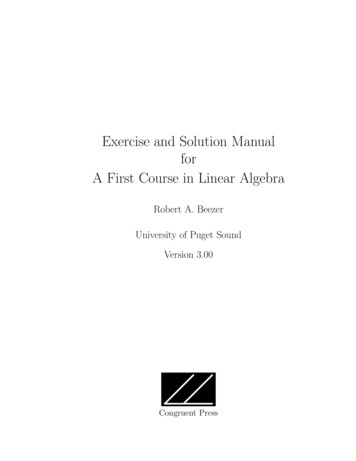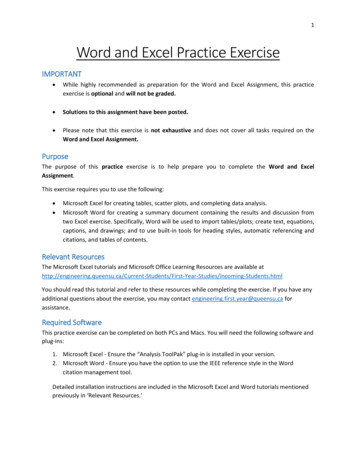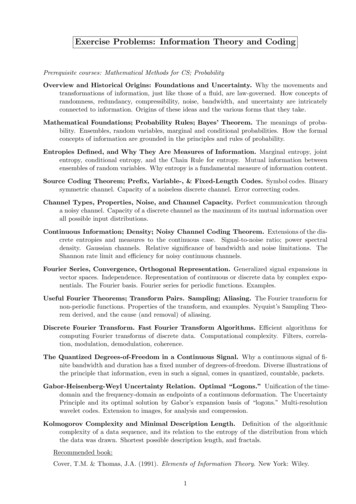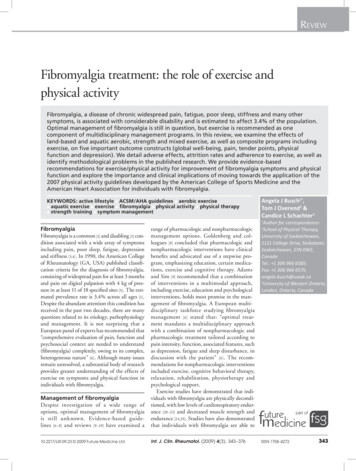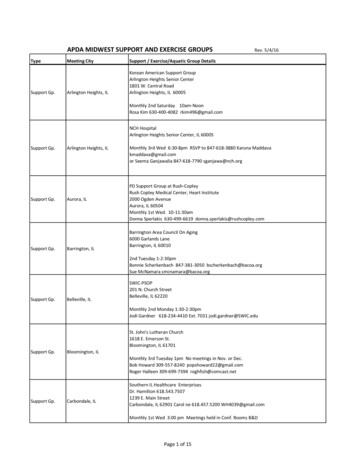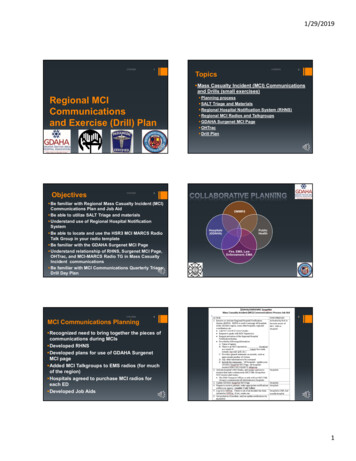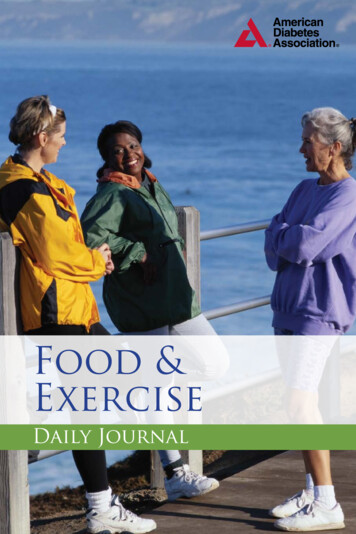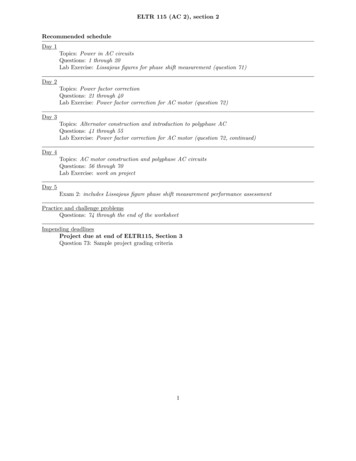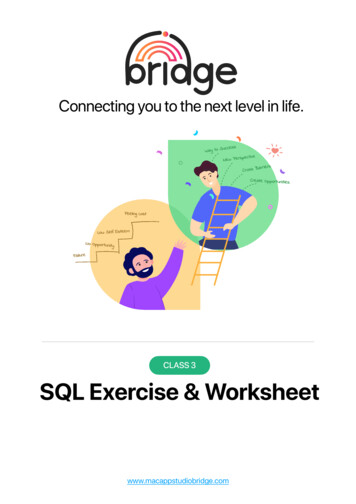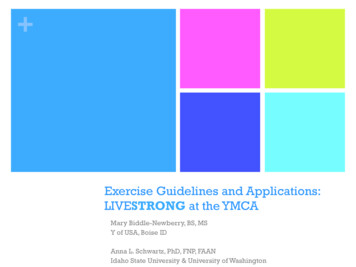
Transcription
Exercise Guidelines and Applications:LIVESTRONG at the YMCAMary Biddle-Newberry, BS, MSY of USA, Boise IDAnna L. Schwartz, PhD, FNP, FAANIdaho State University & University of Washington
“When treatment ends, the warrior and his/her familyoften are not prepared for the fact that recovery takestime. In general, their recovery will take much longerthan treatment did. People often say that they didn’trealize how much time they needed to recover.” .from Facing Forward: Live After Cancer Treatment, NCI
Current State!Over 1.5 million new cases cancer in 2010!Over 12 million survivors alive in U.S.!Burden of cancer!!!!!Morbidity, mortality,Economic cost,Lost work days,Reduced quality of life,Family burden!With increasing survival (and aging population), there is asignificant population that is trying to return to their “new normal”feeling anything but normal!!Need for cancer rehabilitation!Need for exercise guidelines
ACSM Roundtable!Round table and Consensus meeting!International multidisciplinary team!NursingMedicine!Epidemiology!Exercise physiology!!Representation from!Y-USA!!National Cancer InstituteLance Armstrong Foundation!American Cancer Society
Consensus!Recommendations the same as for age appropriateguidelines from the US DHHS Physical Activity Guidelinesfor Americans!150 minutes/week moderate-intense aerobic exercise or 75minutes/week of vigorous exercise!Strength training 2-3 time/week, 8-10 exercises of 10-15repetitions/set, with at least one set per session! AvoidInactivity!!!!Return to normal daily activities as quickly as possible!Continue normal daily activities and exercise as much aspossible during and after non-surgical treatments
Goals of ExercisePrescriptionRegain and improve physical function, aerobiccapacity, strength and flexibility!!Improve quality of life!Improve body composition and body imageImprove cardiorespiratory, endocrine,neurological, muscular, cognitive andpsychological outcomes!Potentially reduce or delay recurrence orsecondary primary cancer!!Reduce, attenuateand prevent long term andlate effects of cancer treatment.!Beinginactive is a risk factor for otherdiseases!
How to Apply Guidelines toPractice!Provide clear instructions to exercise and avoidinactivity!Educate public on how to exercise!Reassure that exercise is safe!Basic exercise instructions:!!At least every other dayBuild up to 30 minutes!Start slowly and Progress slowlyModerate intensity!Choose an activity that is enjoyable!Aerobic and resistance exercises!
LIVESTRONG at the YMCA!to empower cancer survivors to improve functionalcapacity andprogramof fitnessto increaseand strength.their quality of life through an organized!!Individualized to each survivor!!Program is FREE!Individualizedto each survivor!High demand and highly successful program!Program is FREE!
Exercise ModificationsSide EffectExerciseLymphedema Participant should not exerciseaffected limb if they report: Participant should not exerciseaffected limb if they report:tightness, achiness, shootingpain, or heaviness in in in thetrunk or limb-at-risk. Tell clientPeripheralNeuropathy Use caution when handlingweights to avoid dropping Use caution when handlingweights to avoid droppingweights. If toe/foot numbness ispresent, be aware of potentialfor balance problems andincreased risk for tripping andExercise Modification Plan Check in w/participant every sessionand monitor limb. Check in w/participant every sessionand monitor limb. Start at a VERY low weight. Stay at starting weight for at least 2weeks before progressing to nextweight. Progress in the smallestavailable increments. Consider using weight machines orelastic tubing instead of free weights. Consider using weight machines orelastic tubing instead of free weights. Spot client when using free weights. Be physically present to spot client ifthey become unstable when learningnew exercises such as lunges. May need to be cautious in
Exercise ModificationsSide EffectDecreasedRange ofMotionDecreasedImmuneFunctionFatigueAny otherSide EffectExercisecan do through full range of Use caution and choosemotion.weight lifting exercises that clientcan do through full range ofmotion.Exercise Modification Plan Exercises chosen should not replicatepain (above mild). Waterandrangeexercisesof motion.found to be helpful. Exercises chosen should not replicatepain (above mild). Water exercises found to be helpful.with knownmoderateintensity.upper respiratoryinfections or other illnesses. Keep exercise at low tomoderate intensity. If trainer is ill, NO training cancer If skin irritation, or ongoing problemssurvivors.with immune function, avoid swimming. If trainer is ill, NO training cancersurvivors. No exercise that should beavoided. Start exercise slowly and graduallyincrease intensity.away; instruct them to stop and consult withHavemedicalclient slowteam.down and reduceintensity. If symptom does not goaway; instruct them to stop and consultwith medical team.
LIVESTRONG at the YMCAaddresses unmet needs of survivors.!92% Agree that they have made progress related to their healthand well-being goals as a result of their participation in Yprograms for cancer survivors.!86% Agree that they are part of a supportive community at the Y(as defined by 4 measures).!92% Agree that their program leader has the understanding andskills needed to lead a physical activity program for cancersurvivors.!93% Plan to continue their health and well-being journey at theY after the program ends.!94% Are highly-likely to recommend LIVESTRONG at the YMCAto a friend or family member.
Improvement in LIVESTRONG atthe YMCA participants!56% Improvement in leg strength (leg press)!45% Improvement in upper body strength (overhead press)!85% Increase in core strength (abdominal strength)!60% Improvement in aerobic capacity (treadmill or bicycleergometer time to fatigue).!LIVESTRONG at the YMCA is safe.!!Over 2000 participants3 injuries reported
“The LIVESTRONG at the YMCAprogram gave me more thancoaching – it gave me a path for lifeafter treatment. The end of medicaltreatment is abrupt. Once my dailyvisits to the cancer center ended, Ifelt alone and disoriented. I neededa way to rebuild my life as a cancersurvivor. That’s where the medicalsystem ended and the LIVESTRONGat the YMCA program stepped in.”YouTube:LIVESTRONG at the YMCA(posted by LIVESTRONG ARMY)http://www.youtube.com/watch?v aJhC2DPBeyw
Lance Armstrong Foundation ! American Cancer Society Consensus ! Recommendations the same as for age appropriate guidelines from the US DHHS Physical Activity Guidelines for Americans ! 150 minutes/week moderate-intense aerob


